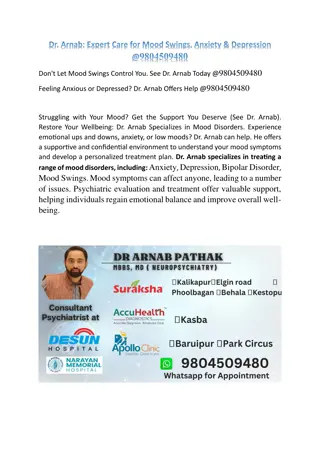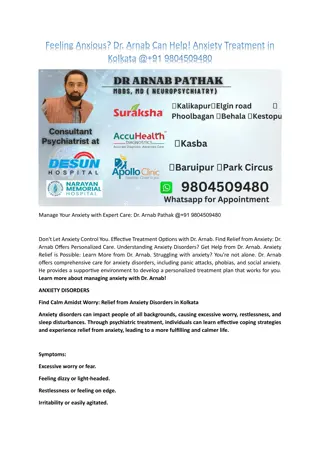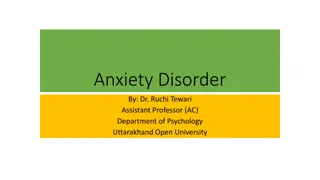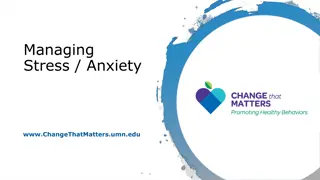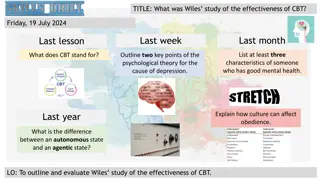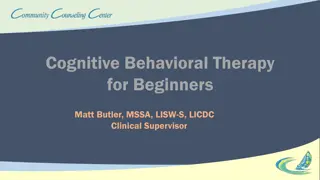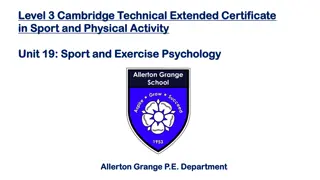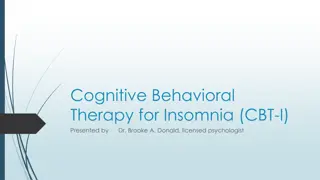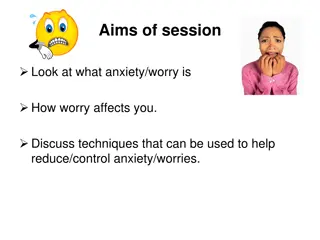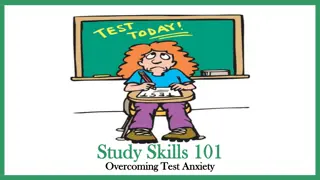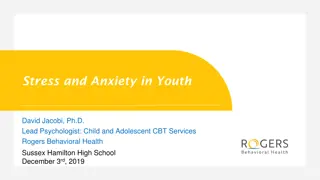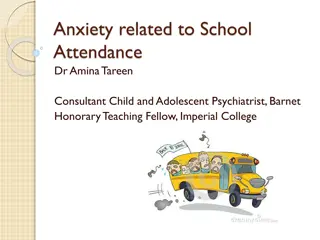Understanding Stress, Anxiety, and Low Mood: A CBT Approach
Explore how Cognitive Behavioural Therapy (CBT) can help manage stress, anxiety, and low mood in the LGBTQ+ community. Learn about the 5 areas model, lifestyle factors, and coping strategies to improve mental well-being. Gain insights on identifying and addressing thoughts, situations, body responses, feelings, and behaviors related to stress, anxiety, and low mood. Enhance your understanding of these common mental health challenges and their impact. Participation in sessions focuses on developing SMART goals and practical skills to support mental well-being.
Download Presentation

Please find below an Image/Link to download the presentation.
The content on the website is provided AS IS for your information and personal use only. It may not be sold, licensed, or shared on other websites without obtaining consent from the author. Download presentation by click this link. If you encounter any issues during the download, it is possible that the publisher has removed the file from their server.
E N D
Presentation Transcript
LGBTQ+ Wellbeing Group SESSION 2 INTRODUCTION TO COGNITIVE BEHAVIOURAL THERAPY (CBT) & LIFESTYLE
House KEEPING Mobile phones on silent/vibrate Microphones on mute when not speaking 10-15 minute break Listen respectfully to others Respect of confidentiality If you need the toilet or have to attend to something at home e.g. children, please feel free to do this and return to the group as soon as you can
Session 2 Overview Introduction to Cognitive Behavioural Therapy 5 Area Model: Learning our vicious cycles of Low mood, Anxiety & Stress The importance of lifestyle on our mood (diet and exercise) SMART GOALS
Session 1 Recap Intro to Stress Fight/Flight Barriers for the LGBTQ+ community getting support for MH
Home Tasks from Last Week Complete your own STRESS BUCKET Write down your COPING STRATEGIES
What is stress, anxiety and low mood? In CBT we often use a 5 areas model to break down difficulties like stress, anxiety and low mood into their different parts: Thoughts: Situation Body: Feelings: Behaviours:
What is stress, anxiety and low mood? What happens to you when you are feeling stressed? In your body? In your feelings? In your behaviours? In your thoughts? What happens to you when you are feeling anxious? In your body? In your feelings? In your behaviours? In your thoughts? What happens to you when you are feeling low? In your body? In your feelings? In your behaviours? In your thoughts?
What is stress, anxiety and low mood? Everybody experiences these feelings at some point in their lives. They become a problem when they are constant, overwhelming or limiting the things we can do. 1 in 4 of us will experience a mental health problem at some point of our lives. 2 in 5 in the LGBTQ+ population
What is stress, anxiety and low mood? There can be many causes for stress, anxiety and low mood. These may be Biological/Genetic Psychological Situational/ socio-environmental They are often a combination of all 3, and sometimes the cause maybe a complex combination of everything.
What MAINTAINS stress, anxiety and low mood? Sam, 44, has a disability assessment coming up. This is causing them to feel very anxious as they find speaking about their health conditions difficult. They also worry whether the health assessor will judge them for being gay and presenting differently. Sam is thinking about it constantly. They stop going to their local art class and put off seeing their friend. Sam has trouble sleeping at night because of racing thoughts and begins to drink a bottle of wine each evening to try and relax. Waking up in the mornings becomes harder as Sam feels physically exhausted and emotionally drained. Sam worries their benefit will stop and they will struggle financially. This causes their heart to race and their stomach to churn. They feel like they're not coping.
What is stress, anxiety and low mood? What would Sam s 5 Areas look like? Thoughts: Situation Body: Feelings: Behaviours:
Group Exercise What does Sam s 5 areas look like? As a group lets discuss Sam s 5 areas
What is stress, anxiety and low mood? Take a minute to think about your own 5 Areas model. What might be maintaining your difficulties? If people feel comfortable, they can speak about their experiences. Thoughts: Situation Body: Feelings: Behaviours:
Why Lifestyle? Taking care of yourself physically and socially can help you manage stress and feel good. Our body is connected to and affects how we feel, think and behave. A tired, stressed body is more likely to make you feel stressed. We are also highly social beings. Some individual differences however, we all need regular contact with others.
The mind-body link and your health Digestive System: It is common to experience an upset stomach (e.g. nausea, diarrhoea, bloating or pain) during times of stress. There are lots of nerve connections between the brain and the gut. Fun fact: In fact, the gut is sometimes called the Little Brain for this reason. People with skin conditions, including eczema or psoriasis, notice that during stressful periods their symptoms can become worse. Can you think of any others?
The mind-body link and your health Pain is both a physical and emotional experience and is affected by the mind and the body. For example, the experience of pain can be affected by stress, anxiety and depression. Fatigue can also be affected by how we think and feel. For example, boredom can lead to feeling fatigued and sleepy whereas an unexpected piece of good news could give you a burst of energy
Exercise: Feel Good Factor When we exercise, several good things happen to our body and mind: Endorphins (the feel-good chemicals) are released into your blood stream helping you feel happier, calmer and better about yourself. Your muscles let go of the tension that builds up when stressed, resulting in your mind relaxing too. You get a sense of achievement, which is likely to increase your confidence
Improved sleep: research has shown that people who exercise regularly fall asleep faster, sleep longer, have better quality sleep and wake up less often during the night. Protection from illness, injuries and aches: working out lowers the risk of coronary heart disease, diabetes, and some cancers. It also lowers bad cholesterol and blood pressure. When your muscles are strong and flexible, they ll support your bones and joints better, therefore making it less likely that you twist your ankle or pull a muscle. Keep your weight in check: you can eat more and not gain weight! You ll tone up your muscles and your skin will clear.
Start Now!? Make time in your life for physical activity it doesn t matter what you do, just find something you enjoy and keep doing it! Even just a small amount of movement releases feel-good chemicals (endorphins) in your body and gets rid of the ones that build up when your stress response is active (cortisol). You do not have to spend hours exercising and it does not have to be a chore. Try something you enjoy and make some room for it in your daily life. Could you go for a walk? Could you walk up the stairs instead of taking the lift?
How Much Exercise? The ideal amount of exercise for an adult (18-64) is about 2 hours a week 30 minutes per day. There are different types of exercise: the kind that ends up in you breaking a little sweat (aerobic) or the one that builds up strength (muscle strengthening). Aerobic exercise is any continuous, repetitive activity that you do long enough for your heart to start beating faster and break a bit of a sweat. For example, walking, swimming, running and climbing stairs. Muscle strengthening exercise aims at increasing the strength, power, endurance and muscle mass. Examples are things such as weight lifting, push-ups etc. It is a good idea to try and have a mix of these two types of exercise.
Tips to get Active Tip 1: Do it! Action precedes motivation. It is very rare for anyone to feel like exercising. Rather, once you start doing something, you then feel like doing it. Tip 2: Reward yourself: People commonly forget to reward themselves for their efforts. Yet doing so is crucial. We learn to keep doing the things that result in some kind of benefit or reward. By rewarding yourself, you are more likely to do it again. Tip 3: Squeeze it in: Finding the time to exercise can be challenging. However, sometimes it is a matter of making it a priority. Thinking that exercise has to take hours might be putting you off. For example getting off the bus a few stops earlier, walking up the stairs instead of taking the lift or walking around the block at lunchtime. Tip 4: Bring company: Exercising is easier when done with someone else. Is there someone you know who may go for a short walk? Or a local group you could join? Maybe you could get a pet or you could offer to walk someone else s dog?
Food & Mood? Is there a link?
Stress - Eater? When we feel stressed, we tend to reach for things that give us a quick feel- good fix. Sugary foods, soft drinks, coffee and alcohol are some of the most common things we reach for when we feel in need of a boost and some comfort. This is a very natural reaction. The problem is that while these foodstuffs often give us a lift in the short term, they end up backfiring in the long run and making our stress worse: These foods are full of simple carbohydrates (or carbs). The body turns these carbs into sugar and burns them up very quickly, giving us a fast energy boost. The problem is that the fast burn leads to a rapid drop in blood sugar levels which in turn can lead to plunging moods and irritability. Further cravings for these foods or sugar highs begin all over again. Making some simple changes to how and what you eat can make a big difference to how you feel.
More about FOOD & MOOD What we eat can affect how we feel Symptoms of low blood sugar include: Nausea Mood changes Trembling Sweating Muddled thinking 95% of Serotonin is produced in the gut (Carpenter, 2012) Nutrient deficiencies can lead to tiredness, brain fog and mood changes Omega-3 and Vitamin B12 have been particularly linked to low mood
Tips On Eating Moderation and balance are key to a healthy diet. Enjoy small, frequent portions Portion sizes have ballooned in the last 50 years or so. Most people simply eat too much at one sitting nowadays. Use smaller plates. This creates an optical illusion, where you think you re eating more food than you really are. When eating out, split a meal with a friend or eat half and ask for the remainder to be boxed up to take home with you. Eat slowly. This gives your stomach time to tell your brain that you re full and should stop eating. It can take 20 minutes for this to happen! Moderate moderation! It s okay to indulge yourself from time to time, you just have to be careful how frequently you do this.
More tips Plan ahead for the times when you know you ll need a quick fix or sugar high Try to eat nuts (not salted or roasted) or dried fruit (dates are nature s toffee!). Or you might try eating a piece of fruit first, before reaching for the chocolate or cookies. Eating well is not about dieting or following a specific diet regime. Healthy eating is about making sure your body gets everything it needs to function well. Balance is the key here: our bodies need the right mix of carbohydrates, protein, fats, and other nutrients to work well. If your body is functioning at an optimum level, your mind will also be in a better place to cope with stress.
KNOWING YOUR NUTIRENTS Complex carbohydrates release energy into your body slowly and produce serotonin, which is calming. Trying adding slow acting carbohydrates such as potatoes, brown rice, and pasta Proteins are essential for the body to repair itself. It is also another source of slow-releasing energy. Protein is found in large quantities in animal products (such as meat, eggs, milk) but also certain vegetables (mushrooms and soya). Grains and nuts are also good sources of protein in smaller quantities. Protein is particularly helpful when eaten earlier in the day. Fresh Fruit & Vegetables are rich in many important nutrients, including vitamins, minerals and anti-oxidants. Ensuring that you eat your recommended five portions a day is also a great way to manage times of stress,
Fats have a bad reputation and many people try to avoid them. However, fats have an important function in our bodies. For example, fats are used to insulate neurons so that they can communicate faster. Try adding Good fats which are found in olive oil (and other vegetable oils), fish, certain nuts, and flaxseeds. Fibre helps your digestive system work properly. You will naturally get enough fibre through your five a day . Water - Many do not drink much water, preferring soft drinks, tea and coffee. Dehydration is a common problem, and can lead to headaches and fatigue. Many of us misinterpret thirst as being hungry. Tip: Try to switch soft drinks or juice for water, and carry a bottle of water with you. Breakfast is a very important meal for preparing us for our day, and yet many of us often skip it. An ideal breakfast will have a mix of carbohydrates, protein and fruit.
ALCOHOL & CAFFEINE Try and limit alcohol, caffeine and sugar in your diet. Alcohol Having a drink or two can leave you feeling more relaxed. Alcohol can take the edge off in the short term, but it is likely to make you feel more edgy in the longer term. It interferes with your sleep and dehydrates you, which can make you feel more tired and stressed. Tip: Limit or avoid alcohol. Try notice whether and how you use alcohol to cope with stress. If you find it has become a main way to deal with stress you may consider cutting back and finding other ways to help you relax. Caffeine Being stressed can leave us feeling drained and tired. Sleeping might also become challenging if we are under a lot of pressure. It is only natural then to reach out for things that will give that boost of energy. If you are already on edge, adding some caffeine to the mix might leave you feel jittery and might get in the way of getting a good night sleep. Be mindful that many energy drinks also contain high levels of caffeine; they sometimes also have other herbal stimulants which may have a similar effect to caffeine. You can replace your coffee with a decaf drink Or avoid drinking coffee 4 hours before going to bed
Smart Goals It is difficult to plan a journey when you don t know where you are heading. Set yourself some goals that will help you make the most of this workshop. Make sure they are: 1. Positive (focus on things you will start doing, rather than stop doing) 2. Specific and Measurable (so you know when you have achieved them) 3. Achievable and Relevant to your values (set yourself up for success) 4. Time-limited (know when you want to start and finish by) Not too many (we suggest two or three)
EXAMPLE OF SMART GOALS For example, Sam decided to set three SMART goals: 1. To make an appointment with the job centre by the end of the week. 2. Sign up to an employment website by Friday this week. 3. To walk the dog for half an hour every other day with his partner starting today.
LEARNING TASKS & Next Session Complete your own 5 Areas Diary Think about your lifestyle & Diet and how this may impact your wellbeing. Set yourself a SMART GOAL Next Session 3: Getting Active. Why scheduling activities is key to better mood.
Well Done & Thank you for Coming See you Next Week!



